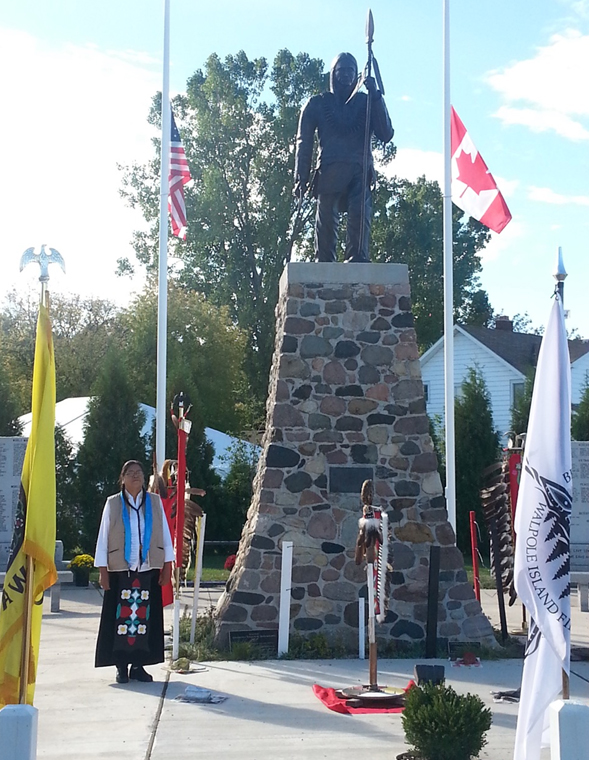Tecumseh sculpture unveiled on Walpole Island

By Rick Garrick
Wikwemikong’s Georgina Toulouse Bebamikawe recently unveiled a seven-and-a-half-foot bronze sculpture of Tecumseh overlooking the St. Clair River on Walpole Island.
“He’s done in buckskin and he’s dressed up like a warrior,” says Joyce Johnson, director of the Walpole Island Heritage Centre. “A lot of the community members wanted to see (him in buckskin attire) instead of being dressed like a British soldier.”
Johnson says the community began working on the development of the Tecumseh statue in the 1930s. Tecumseh was buried in the community a number of years after his Oct. 5, 1813 death at the Battle of the Thames. The Tecumseh statue was unveiled on Oct. 5, 202 years after his death. Tecumseh was the leader of the Shawnee and an ally of the British in the War of 1812.
“His warriors hid his body and then they buried him just outside of Moraviantown or the Delaware Nation,” Johnson says. “He was left there for a number of years and then one of his warriors had him moved to our reserve, and he was reburied at St. Annes Island.”
Johnson says Walpole Island was chosen as Tecumseh’s final resting place in the 1930s after meetings between neighbouring First Nation communities in both Canada and the United States. The community’s Soldier’s Club raised funds to create a monument at the Veteran’s Memorial site, where Tecumseh’s remains were placed in 1941.
“The last responsibility was to do the statue, and it has taken us about 75 years to get the money to build the statue,” Johnson says. “We have finally been able to do that for our Veteran’s Club and the old Soldier’s Club.”
Toulouse Bebamikawe, a sculptor originally from Wikwemikong who has been living on Walpole Island for about four years, says the community loves the Tecumseh statue.
“I still get compliments here when I see people,” Toulouse Bebamikawe says. “They say: ‘Hey, you did a good job, I love it.’” Toulouse Bebamikawe created the buckskin design for the Tecumseh statue after conducting consultation sessions with Elders and community members. She also did research on Tecumseh at the Royal Ontario Museum in Toronto.
“I wanted to make sure it had lots of texture,” Toulouse Bebamikawe says. “That is why I chose the leather and fringe.”
Toulouse Bebamikawe also created movement in Tecumseh’s hair and clothing to emphasize the action of the wind.
“I wanted to show it was windy where he was standing,” Toulouse Bebamikawe says. “I wanted to make sure that there was that movement on his breechcloth, the movement on the feathers — I added feathers on the spear. I wanted to make sure he didn’t just stand there rigid.”
Toulouse Bebamikawe first built a full-size model of the statue from rebar, metal mesh, foam and clay, which was used to create about 72 patterns for different sections of the statue.
“After that it goes to the foundry,” Toulouse Bebamikawe says. “In the foundry they make sand castings; that is where they pour the hot bronze.”
Toulouse Bebamikawe says her son and her nieces helped create the model due to her time constraints — she only had four months to create the statue. Her son worked on Tecumseh’s tomahawk and spear while her nieces worked on forming different parts of the model. Her brothers also helped with the final installation and unveiling of the statue.
The statue is located at the corner of Tecumseh and River Roads about one mile from the ferry landing.
A short clip of the statue unveiling ceremony is posted at www.youtube.com/watch?v=xklzXP7fSQw.


